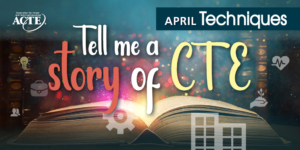How can you connect your students with careers that fit?
Scheduling and placement challenges are a systems problem, a disconnect between CTE program awareness and the mechanics of course scheduling. Here we’ll look at two examples — from Oregon and Kansas — of successful, systematic approaches to helping students discover their interests and aptitudes and learn about related career pathways.
Henley Middle School and Henley High, Klamath Falls, Oregon
“This is my 16th year in education,” said Adam Randall, CTE coordinator and instructional coach at Henley High School. “And by far the best time spent has been in CTE.” Randall has worked at Henley for the past six years, and as full-time CTE coordinator since 2020. Previously, he taught engineering and advanced math at another high school and also supported the CTE programs on a part-time basis. He was an engineer before he came to teaching.
Randall said that the former principal, Jack Lee, saw the trends toward workforce preparation and CTE and pushed hard to develop new programs for students. Lee advocated for hiring a CTE coordinator. Because he knew that principals and teachers had too many other responsibilities to do this work effectively.
Discovering what you’re good at
So, the school teams developed a comprehensive process to assess students’ interests and aptitudes in eighth grade. Then they would use the results to guide high school recruitment work for Henley’s CTE programs.
In January or February, all of the district’s eighth graders take the career aptitude assessment across two or three class periods. Students use technology to identify 25–30 careers that match with their aptitudes and about which they want to learn more. Then they collaborate with teachers, administrators, and their families to discuss and narrow down their pathways. Students also learn about the CTE programs and other opportunities at the high school, and how those programs might relate to those career options.
Students keep all these items documented on a planning document called the “Forecasting Draft,” and the word “draft” is emphasized continuously. Randall said, “So many students and families worry, like, well, if I choose engineering as my number one, then that’s engineering for the rest of my life. And I tell them, ‘No, no, you’re not making a forever decision. You’re making a for-now decision’.”
Eighth grade students also benefit from a career exploration day at Henley High. Students are placed into groups of 15 or 16, and they rotate through approximately 12 stations, each featuring a hands-on activity. Middle school students are led by current high school CTE students, and they’re encouraged to talk and ask questions.
Shawnee Mission School District, Shawnee Mission, Kansas
Ryan Flurry is the CTE coordinator for the district and principal of the two centralized career education campuses. He has been in this role for six years and worked previously as a high school associate principal and a chemistry teacher. “It has always been a passion of mine to help students explore various career paths,” he said. “In the science classroom, I often saw students fixed on one career choice, and I wanted to encourage them to consider different aspects beyond a single option.”
Discovering what you’re interested in
At Shawnee Mission, students take aptitude assessments in seventh and ninth grade. The results help them decide which career fields to research and can guide their decision-making about course and program enrollment. Flurry and other faculty use results from the assessments and analytics to help develop awareness-building activities, such as tours and other events. They identify the pathways and related activities, then use system analytics to invite students who may be interested and/or who are traditionally underrepresented in those fields.
Shuttles facilitate students’ transportation from students’ home schools to centralized CTE locations for career fairs. Because the buses are already running. There, they can explore career pathways they may not otherwise have access to.
“We recently hosted an engineering event,” said Flurry. “We brought in students with an aptitude for engineering, connecting them with young professional engineers and college representatives. The turnout was fantastic.” Another recent event brought ninth grade students to see the fire science and first responders’ facilities. Flurry continued, “It’s about creating awareness. Many students aren’t aware that Shawnee Mission has a fire science program, and that they can graduate and potentially get hired at 18.”
Additionally, they will cross-reference the families’ contact information. “This allows us to send emails to both students and their family members.” Flurry noted the importance of connecting directly with families. “It’s a collaborative effort involving the whole school community.” While he takes the lead in creating the recruitment, “our counselors are the ones sending out the invitations. They act as the face of the school.”
Tips for using career aptitudes in CTE recruiting
- Administer a high-quality, aptitude-based assessment to identify potential talents for development and career exploration. A traditional interest assessment can complement the career aptitudes assessment.
- Review assessment results and give your students adequate time to process, reflect and ask questions — in the school environment and within their home communities.
- Help students gain a general knowledge of different industries and career pathways through hands-on, engaging career exploration activities. They need to know more about how the real world works and how people in different industries work together.
- Share information with your students about the secondary and postsecondary CTE programs available to them in your region. Share this information with students’ families as well. Be proactive in your communication style.
- Host an open house at the high school and/or regional CTE center. Arrange opportunities for students to rotate through the programs offered to learn more.
- Encourage a “career-connected learning for all” approach in your school district, so every student has access to career exploration, even if they don’t enroll in a CTE program.
- Continue the career conversation at every grade level. Remind them they are only making “for-now decisions.”
Hans Meeder is senior fellow for education and workforce innovation at YouScience. Meeder is the author of The Power and Promise of Pathways and several other books. He was co-founder of the National Center for College and Career Transitions and also served as deputy assistant secretary in the U.S. Department of Education’s Office of Vocational and Adult Education.




